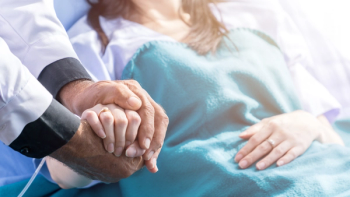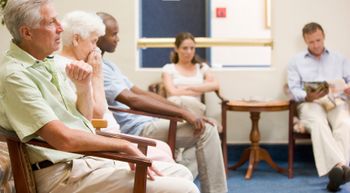
The COVID-19 Diary of the University of Colorado Cancer Center
Dr. D. Ross Camidge shares with CURE® a diary of his dealings with the COVID-19 pandemic at the University of Colorado Cancer Center as life changed for his team and his patients.
Dr. D. Ross Camidge is the director of thoracic oncology and the Joyce Zeff Chair in Lung Cancer Research at the University of Colorado Cancer Center, that had to rapidly react to the developments of the COVID-19 pandemic.
Here, Dr. Camidge details the early days of the pandemic’s effect on cancer treatment and how it crystalized for him the experiences patients with cancer were already going through prior to the pandemic.
Colorado Cancer Center COVID-19 Diary
March 5th: The first confirmed case of COVID-19 in Colorado is reported in a young man who had been on vacation to Italy before continuing his vacation amid the skiing and snowboarding crowds up in Vail.
March 10th: While I am in my lung cancer clinic, I get an email from Harry Ren, a doctor from the Shanghai Pulmonary Hospital who had worked with us previously. He had heard COVID-19 was in Colorado. Harry warns me to wear protective equipment, to keep myself and the team safe. Over 3,000 Chinese doctors and nurses have gotten sick from COVID-19.
March 11th: The World Health Organization officially labels COVID-19 a pandemic.
March 12th: We admit our first lung cancer patient with COVID-19 symptoms — a potential “patient zero” for us. Bert, short for Roberta, is a wonderful 77-year old retired publisher, who appeared to be responding to her treatment but then developed increasingly difficult breathing and low-grade fevers over a week.1 On her CT scan there are new infiltrates in both lungs. She had received immunotherapy together with her last chemotherapy which can cause inflammation in the lungs. We send blood tests for different infections, including COVID-19.
Bert is stabilized and kept under isolation conditions. Steroids, which can be used to treat inflammation in the lungs, but which could worsen some infections, are kept in reserve while the test results are awaited.
March 16th: All my work meetings have become virtual. From our respective rooms and offices, the clinical and research teams discuss ongoing clinical trial accruals; then new and difficult cases in our weekly Tumor Board.
March 17th: My clinic has changed dramatically. I see a fraction of the patients I would normally see in person; the rest are through telehealth appointments. Our scheduler jokes that tech support for older patients has now become an everyday part of her job.
March 19th: There is little traffic and I get rock star parking at the clinic. We still do not have the COVID-19 results back on Bert. It has been 7 days since she was admitted. Her other infectious tests are all negative.
I do my usual phone call with the thoracic oncology consortium that I direct — 14 University Hospitals and Cancer Centers across the USA and Canada. Patient accruals to clinical trials are down. Everything is becoming bottlenecked. Patients are scared. Staff are scared. However, the feeling on the call is that, as doctors, this is what we went to medical school for.
Because medical situations are the explosions we run toward rather than away from. In medicine, we are used to chaos. We are used to finding and protecting the possible, under a barrage of the uncontrollable, the impossible.
On the call among my colleagues, we all feel as if we are the shepherds of our own flocks. Patients with lung cancer are, in theory, no more susceptible to catch COVID-19 than anyone else, but if they do catch it, they will have a higher risk of dealing with the worst of the symptoms COVID-19 has to offer.
I finish off the day with a Remote Second Opinion from Israel.2 In Haifa, the patient and her children are now faced with not just the stress of her lung cancer growing, but a new kind of stressor. To determine the next best treatment would require a biopsy but going into the hospital to get this done could increase her risks of COVID-19 infection. To not get the biopsy would mean hunkering down with a progressing cancer or switching straight to chemotherapy in the absence of rational alternatives. The risks they are most worried about all relate to catching COVID-19. The risks from her progressing cancer appear clearer.
There are internet adverts for virus killing light-wands. Hydroxy-chloroquine, an anti-malarial and anti-inflammatory agent, is being thrown around as a possible ‘treatment’ for COVID-19 without any debate about the source or extent of the data available to support these claims. I revisit how patients with cancer can fall prey to promises of miraculous results from unproven treatments simply because they so desperately want the good news to be true.
March 21st: I get Bert’s COVID-19 test result back. She is negative. She finally starts steroids and her treatment can move on. It took 9 days to get her results back and we can only test people who are in-patients in the hospital. Any attempt to halt the spread of the virus by isolating known positive people using these tools is doomed to failure.3 Instead we have only one solution for the entire population: Keep distant, keep clean.
March 26th: Colorado as a state is ordered to stay at home. In the Cancer Center, we set in place jeopardy and double, triple and quadruple jeopardy plans. Who covers whose patients in the event one of our lung cancer doctors gets quarantined or sick. We even establish back-ups across other tumor-types in case whole teams are incapacitated.
March 31st: My thoughts on the similarities between how we are all dealing with COVID-19 worldwide and what patients with cancer have already been through from the moment they were diagnosed crystalize after a particular conversation in the clinic. The patient said to me, “Now you know what it’s like.”:
This is what not knowing whether you will be well next month or on the verge of death feels like.
This is what not knowing if you will be financially ok or ruined because of matters beyond your control feels like.
This is what worrying that every minor symptom is the start of something far more deadly feels like.
This is what consuming every piece of news, hoping for a breakthrough, knowing that most of the breakthroughs you find are not real, but you still consume them because anything is better than nothing, feels like.
This is what watching others die and wondering if you will be next feels like.
But now we have to worry about COVID-19 as well.
That same day I see Bert again. She looks great and feels great. Her treatment, without the immunotherapy, is set to continue. Life goes on.
Notes:
- All patient names and potential identifying features have been changed.
- https://www.lungcancernews.org/2019/08/14/accessing-lung-cancer-experts-from-anywhere-in-the-world/
- When we moved from sending out the COVID-19 test to performing it in-house at the University of Colorado, including repurposing research minds and hands and research machines for the ‘war effect,’ our turnaround time for getting the results back dropped to 2 hours for Emergency Department cases and 16-24 hours for in-patient cases.





